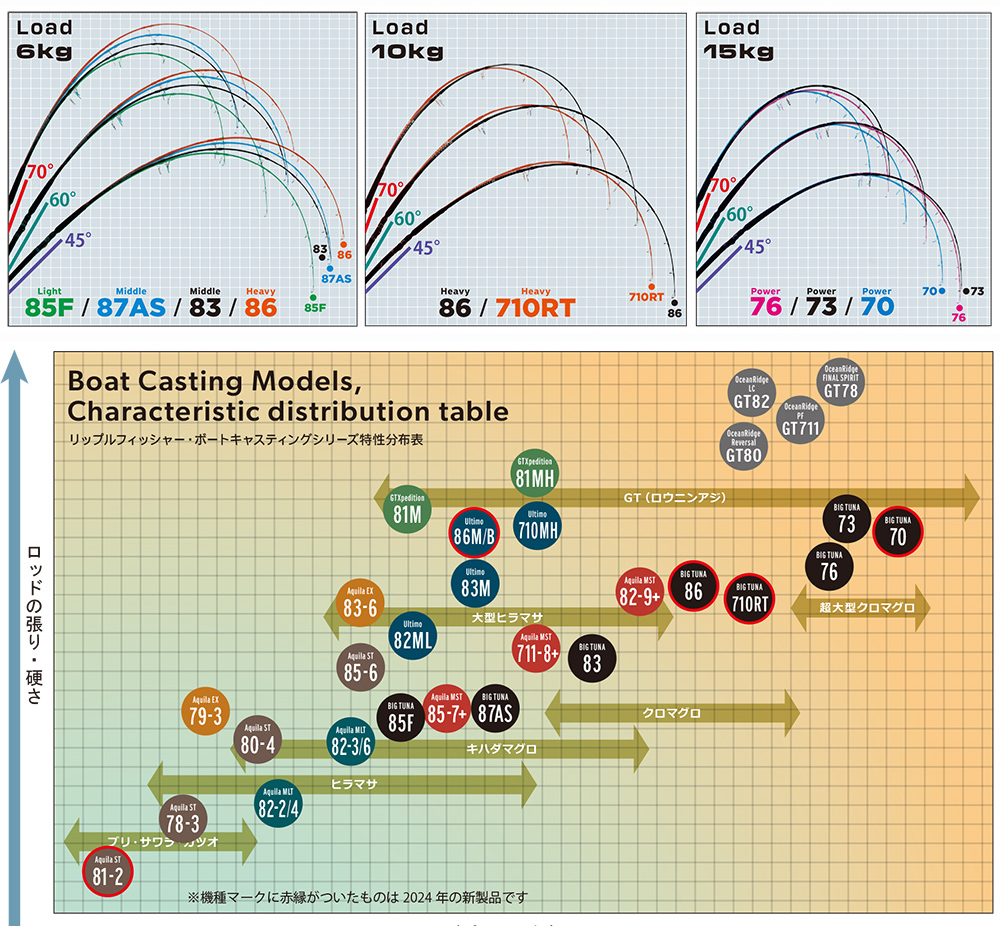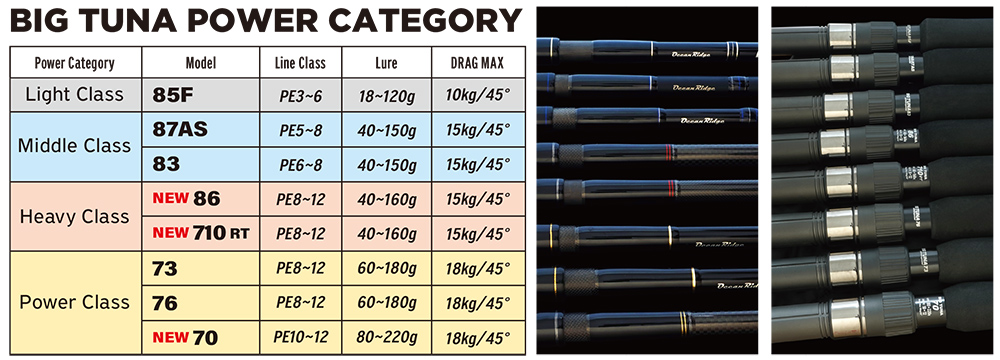Big Tuna 710RT Japan Special - This model has been redesigned to match the current tuna scene, which has changed significantly since the first model was released. The taper design has been adjusted to make it easier to catch fish by bending the bat, allowing anglers to efficiently use bat power to lift during fights. Not only has the rod become softer, but it has also become a well-balanced heavy class model that can be easily manipulated in both luring and fighting. This model is the best if you want to spend a day inviting people in the heavy class.
| target | Tuna species |
|---|---|
| Guide specifications | Ocean Guide (Fuji) |
| drag max | 15kg/45° |
| Length | Weight | Section | Lure | Line | Action |
|---|---|---|---|---|---|
| 7ft 10in (closed dimension 1670mm) | 407g | 2pcs grip joint | 40~160g | PE8~12 | Regular |
◎Applicable reel guideline S/D: 18000~30000
Grip length / 838mm (total grip length), 520mm (from grip end to reel foot)
Blank tip diameter / 3.4mm (directly below the top guide), Blank original diameter / 15.4mm (original diameter) (Outer diameter of the fishing rod body is 930mm from the rod end)
Reel seat / DPS20 (Fuji) Downlock
Grip end / BRC specification
BIG TUNA Bending Curve
Big Tuna static load comparison
This is a comparison of the bending of the Big Tuna series by applying a static load to each power class and changing the angle of the rod. Please use this as a reference for changes in the bending fulcrum, the rest of the bat, etc.
*Please note that changes in bending angle caused by differences in length do not necessarily reflect rod power.
The 85F and 87AS, which are designed to focus on small lures, have a tapered design with a deep bend and a tip that allows the tip to fit in, so they are good at casting small lures and "cat fights" that are less stressful for the angler. On the other hand, the 83 and 86, which focus on floating, have a shallow bending margin and the fulcrum of the bend is slightly closer to the tip, allowing for speedy fighting. Between the 87AS and 83 in the same class (middle class), the 83 feels stronger by about 1 power.
A comparison of the two heavy class models shows that both models have relatively similar taper designs, but the characteristics differ depending on the length. By bending the 86 firmly, it has excellent long-distance casting performance that takes advantage of its length. Since the 710RT is short in length, it is a model that emphasizes balance and is easy to bend during cast fights.
Comparing the three models in the power class, if you look at the 73 and 76 at a 45-degree angle, they appear to have almost the same power, but by bending the rod with the rod upright, the 76 bends from the hand side, which puts less stress on the angler. Since the 73 has a shallow bend, it is possible to fight with a sense of speed. The newly added 70 has the strongest bat power, and because of its short length, the fulcrum is closer to the angler, reducing the burden to the utmost. Although the three models are in the same power class, they each have very different characteristics. *When choosing a tuna rod, please choose one that suits your physique, physical strength, and experience.

The BIG-TUNA series has set power categories to make rod characteristics easier to understand.
To give an example, even though models such as 86, 710RT, 73, 76, and 70 have the same line max value, the 73, 76, and 70 have been developed with higher breaking strength to aim for ultra-large class models, and the 86・This is a different power category from 710RT. The 86/710RT is a model that is useful in situations where long distance casting is required, such as inviting out, or in situations where more detailed invitations are required.
The 85F, 87AS, and 83 are also useful for targeting yellowfin tuna, and as a general guideline, the 85F is suitable for tuna of 50 kg or less, and the 87AS and 83 are suitable for 80 kg or less.
Please choose a model by comprehensively considering the lure size, line, tuna size, required lure appeal, etc.
The rod design of the BIG-TUNA series is color-coded with thread colors that match the power class below. The model name is also engraved on the spacer on the reel seat of the grip.







